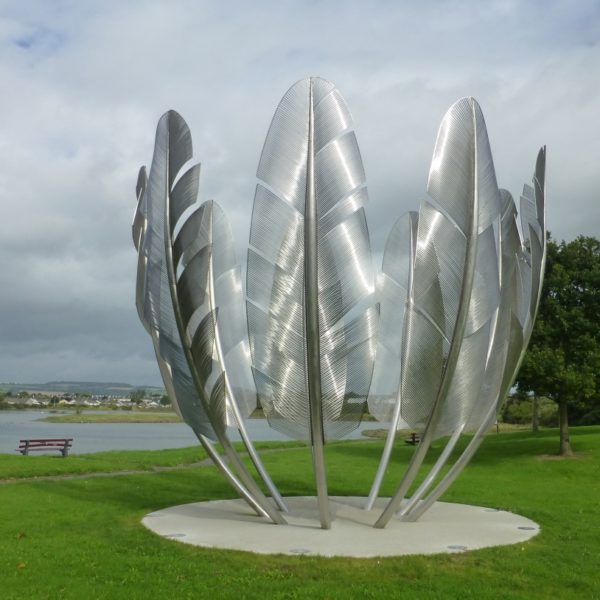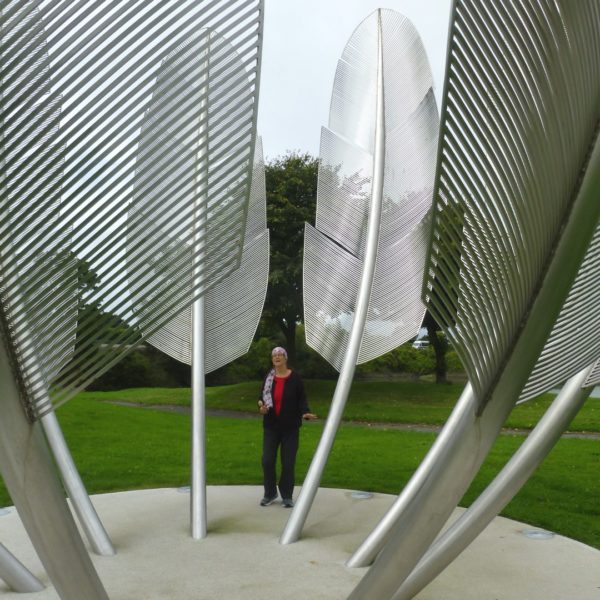A Dances of Universal Peace dance, the Choctaw and Irish people, a sculptural monument, and a humble ceremony. How do these all come together?
Here’s the story: Two of our beloved DUP leaders, Larry Taylor and Lynda Aiman-Smith, created the Choctaw-honoring Hashtali Elements Dance for our North Carolina DUP community a number of years ago, Lynda being of Choctaw lineage. (Her Choctaw great-great-grandmother married an Irish settler.) A few years ago they moved away from us, and then, sadly, Larry, an incredible musician, passed away. My husband, David, is of another Native American lineage (his Ojibwe great-great-grandmother also married an Irish man), and we’ve always loved this dance. When we heard about the unveiling of a Choctaw Monument in County Cork, Ireland, where my Irish ancestors are from, we were determined to go to it. In September, 2016, we traveled to see the Choctaw memorial sculpture, “Kindred Spirits,” created by Alex Pentek.
The sculpture is magnificent: Nine bright stainless steel eagle feathers, twenty feet tall, each different, looking strong against the trees, light and airy against the sky, shining in the sun. It is beautifully set in a lovely biodiversity park. The bowl shape represents an offering of food for the hungry. Pentek created it in gratitude to the Choctaw Nation. The removal of the Choctaw on the “Trail of Tears” was in the 1830’s, yet it was in 1847, such a short time later, that the tribe raised $170 (equivalent to about 5,000 of today’s dollars) to send to the Irish Great Famine relief, joining in solidarity with them for the mutual losses of their people, lands, traditions, language, and religion. We are so moved by this shared history of suffering, colonization, genocidal oppression, and compassion.
One of our primary missions for this Ireland pilgrimage was to pray to our deep-time Irish ancestors and ask for their connection to deep-time Native American ancestors, inviting their combined wisdom in these dire times in which we so urgently need to remember how to reunite with and honor sacred Earth. The monumental sculpture was the perfect place for a small ceremony. We lit a candle in the center and prayed passionately for light to come into this relationship between our peoples, past and present, and with Nature. The concrete platform was just big enough for us to dance the sunwise circling of the Hashtali dance, raising our arms from heart to Creator (Hashtali), touching Earth with our steps, as we moved with each of the Elements, air (mali), water (oka), earth (yakni) and fire (luak). The feathers were spaced out just right to dance the into-center-and-out movements, raising our voices up through the circle of feathers to the circle of sky they enclosed. It was as if the dance and the sculpture were made for each other! Round and round we danced, rattling and singing Hashtali. Then we circled the monument sunwise, sprinkling offerings of biscuit crumbs in gratitude to the loving spirits of this land.
Later we sang Hashtali to one of our Irish guides, Pius, who leads earth-spirituality walks. He was very interested in the whole story and wanted to transmit it to folks who come to walk with him. When we return to Ireland, this fall, God willing, we hope to dance this dance with a group of Irish friends and share a small ceremony. The dance goes on. Now, as I write this, we read that a Choctaw delegation will arrive in June, 2017 for a joint unveiling of this gorgeous and moving monument.
We are learning that Irish and Native American ancestors were connected in the past and that people are continuing to honor these deep connections now. May their combined wisdom and teaching of mutual love and compassion fill us with hope and the spiritual strength we need in order to honor our shared, sacred Earth.
Copyright © 2017 Betty Lou Chaika
Update:
Here is a July, 2017 Choctaw report on the amazing event. Now that was a Ceremony! Wish we could have been there!


Nancy Tusa
This is an amazing and wonderful story, Betty Lou! And what a beautiful sculpture! I, too, am very moved by the Choctaw’s generosity toward the Irish people. Being of Irish descent, this makes me feel a deep sense of connection and shared experience with Native Americans–one that I hadn’t realized before. As you say–both have experienced such a great loss of people, culture, religion, language, and relationship with the land.
Did you and David get to return to Ireland the next year and repeat the Hashtali dance with your Irish friends?
Betty Lou Chaika
Yes, Nancy, the Irish and the Choctaw peoples recognize their shared history of oppression and the compassionate connection of their Irish/Choctaw ancestors. It gives me hope that someday there might be outreach on the part of us colonialist descendants to try to heal our relationship with the Native Americans we have oppressed. Yes, we did get to return and dance Hashtali with Irish friends!
True Grace
This was so informative and enlightening. I am also Irish/Welsh and Native(Potowatomie Tribe) and my husband and I , he is Kickapoo, now have a goal of doing the same dance, God willing , in the very near future and wish to Thank You for that! Bless you and all of our Ancestors as well . What a wonderful way to honor and treasure the past and future of our people , Our Creator and Mother Earth.
Betty Lou Chaika
True Grace, thank you so much for your warm note and your enthusiasm to honor our Celtic and Native Ancestors, Creator and Mother Earth. My heart glows to know that you will dance Hashtali. Blessings on you and your husband and on our shared guidance to do our parts to bring our peoples together in love.
Marilyn Culbertson
Beautiful story. My grandmother came through Ellis Island. Not surprised I never heard this story. Thank you for sharing it. I must tell my children.
Betty Lou Chaika
Marilyn, I’m happy you will connect the generations through sharing the story with your children. The Choctaw/Irish relationship continues on.